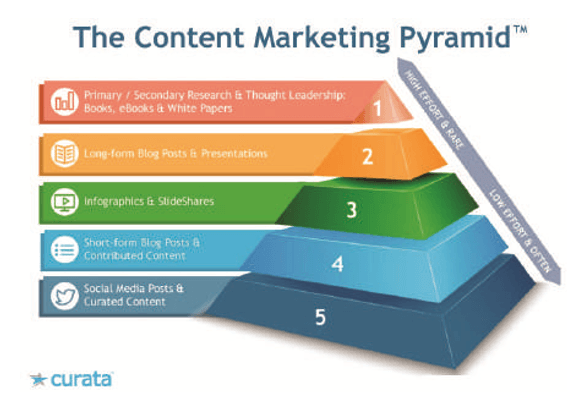The Actual Management of Content

by Maja Mrsic
16 Jan, 2023
Poorly designed content marketing campaigns can make even the most ambitious projects crumble.
Marketers get so caught up in managing different tools and systems for multi-channel campaign delivery that they fail to recognize the most important part of this marketing mission: strategy.Running a strategic content marketing campaign is essential for achieving business success. Period. It will change a Web professional's fundamental approach to running a marketing campaign and help them stay focused on the ultimate goal.
What is the best way to run campaigns efficiently without much fuss? Here are a few tips to consider when managing the day to day:
1. Use a content marketing pyramid
Creating content without a strategy is a dead-end street. By producing a huge amount of content without having a clear idea of how to deliver the message, marketers are entering a vicious circle that usually ends up in a failure.
Those suspicious that they are indeed lacking underlying strategy may want to consider implementing a solution such as the Curata Content Marketing Pyramid, a framework devised to help business writers develop a predictable stream of successful content and coordinate their marketing efforts.

2. Create templates
Templates are a holy grail of any successful business as they can keep marketing assets consistent across campaigns and even departments. They are patterns that help marketers develop a detailed content marketing plan, which enhances their company's productivity and reduces a team's overall stress.
There is a wide range of templates to create, but according to Content Marketing Institute, there are a few essential ones that every marketer should use:
+ Planning template
+ Content questionnaire
+ Buyer persona template
+ Content mapping template
+ Editorial calendar template
+ Template for tracking keywords
+ Web page template
+ Social media conversion calendar template
+ Facebook engagement spreadsheet template
+ Sales communication template
+ Editorial calendar template
3. Segment your market
Companies that do not devote too much time on market segmentation, or who take it for granted, could be missing out on simple ways to boost key performance indicators.
Segmentation includes partitioning a desirable market into groups of customers and prospects, which have the same value and exhibit similar purchase behavior. The market could be segmented according to the following criteria:
+ Geographical (regions, cities, states)
+ Demographic (age, gender, income, occupation)
+ Psychographic (lifestyle, personality, values)
+ Behavioral (occasions, benefits, loyalty status)
Segmentation can help companies increase profits without feeling pressured by the everyday competition on the market since they are marketing to smaller, more relevant groups.
For example, if marketers are facing a large consumer market that is driving high costs per lead, a market segmentation based on vertical industries and product offerings (where each page has unique content targeted to the ideal customer profile) can significantly decrease costs.
4. Listen more than you talk
Only 12 percent of brands reply to customers on social media according to 2017 data from Sprout Social, which means companies are failing to listen and act on incoming messages. Instead, they are talking "at" audiences.
It is a common misconception that companies need to post their content anywhere and everywhere. Marketers should spend more time evaluating each social channel they are planning to use, opting for a few adequate ones and spending more time "listening" than "talking."
By "hearing" how consumers are talking about a brand and what they are sharing on the brand's behalf, companies can start to form a plan based on what is important to their end-users.
5. Use videos
Today's market offers a huge selection of media channels. Sometimes, the messages businesses are trying to convey are too complex or they need to be seen in action in order to produce desirable effects.
According to some experts, we are 90 percent visual beings. Therefore, a video is an excellent way of explaining ideas in great detail, in a fun, enjoyable form. Studies over the years have also shown that videos can increase purchase intent by a significant percent.
6. Choose the right tools
One of the top prerequisites for designing a meticulous content marketing campaign is a toolbox that will help teams work through each step.
Enterprises should strive to treat every single activity as a separate campaign and choose user-friendly tools that will help marketers bring each element to new heights. For example, if marketers have countless ideas with as many tedious tasks to bring those ideas to fruition, a project management tool can help or if a non-designer needs to create social graphics, they could look to one of the many drag-and-drop illustrators available.
Likewise, if a marketer needs to track their campaign's performance using a third-party tool, they can turn to Google Analytics, Kissmetrics or one of the many others. Finally, to maximize content's search-friendliness they can leverage tools like Moz or SEMrush.
7. Create a local knowledge library
While the Internet is an endless resource of every imaginable piece of information, it can still be a time waster when searching for research-based data.
Marketers can open the door to greater efficiency by creating a central library, which would be a place where team members will be able to access company assets and training materials. This should serve as a knowledge hub where teams can stay attune with the latest news and locate project material quickly.
8. Focus on customers' needs
The customer is king. When creating marketing strategy, the most successful companies place their customers and those customers' experiences as their top priority.
If a company wants to develop a successful strategy, its main concern should be a target customer. Instead of organizing its team around media channels, marketers need to make everyone realize how important it is to focus on a customer lifecycle as a whole and then move on to campaign segmentation and, finally, channels.
This will prevent any inconsistencies and make clients or colleagues want to continue collaboration.

9. Create a documented content strategy
Most companies, especially startups, are so focused on delivering results, yet they do not have a documented content strategy. What many of these companies seem to forget, however, is that their content marketing strategy should not be driven by content, but rather by the desired end goal.
Since after launching a content marketing program, marketers will be preoccupied with creating appropriate content, monitoring their channels and delegating tasks to their team, it is vital to document a strategy initially.
A playbook should specifically outline customer segments, content topics and marketing channels. It will make every campaign more likely to succeed.
Happy Managing
Over the last few years, content marketing has become instrumental for all brands. The practice has an immense impact on potential customers and those who decide to ignore it or approach it without a documented strategy will fall behind.
+ This updated article ran in the September issue of Website Magazine; we previously ran a version of ActiveCollab Writer Maja Mrsic's article online, here.

Maja Mrsic
Maja Mrsic is a content marketing specialist with six years of experience in creating, editing, and proofreading content for diverse businesses including marketing agencies, SaaS companies, outsourcing companies, and IoT and digitalization providers. Her passion for writing and focus on delivering the best results is combined with a love of creativity and innovation. She has a natural interest in social media, content creation, employer branding, campaign organization, and management. With a firm grasp of the latest trends and a willingness to experiment, Maja is driven to deliver the best results in fast-paced, deadline-driven environments.









